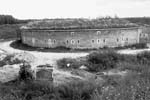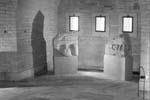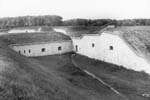|
Even though some
parts of the fortification system were
demolished and the defensive ring was
destroyed as early as the first half of the
20th century, the whole building still
exists. Some parts of bastion I were also
demolished; only Bratislava Gate and some
parts of the retranchments survived. The
fort wall between bastions II and III was
demolished due to road construction, while
the section between bastions III and IV was
knocked down when the railway that leads to
Gúta (Kolárovo) was built. Quite a long
section of the walls between bastions IX and
X of the Vaag Line has also disappeared.

|
The area of the Old and New Fortress was
occupied by the soldiers of the Soviet Army
between 1968-89. During this period the
state of the buildings there deteriorated a
great deal. In parts of the Vaag and
Palatine Line various industrial,
agricultural warehouses and industrial
plants owned by private companies are
currently being operated. This, of course,
doesn’t have a good effect on the condition
of the buildings; and even in their usage it
does not represent an ideal solution. The
unusually extensive fortification system in
Europe with its good geographical position
and quite good condition requires the
implementation of a plan which, apart from
saving valuable monuments, would ensure the
satisfaction of the demands of the great
masses of the people.
A very important aspect is that building
institutions other than that in the fortress
would be a more demanding task both in terms
of time and money. The theoretical choice of
the suitable buildings, which would
correspond to the common purposes, has
already been made, but some changes are
feasible regarding the technical condition
of some of the buildings. In the objects
which most evoke the original states of the
buildings , the operation of museums seems
to be the most reasonable use. We have to
ensure that in the future centre the
fortification system would become a leisure
centre that would be part of the citizens’
everyday life in Komárno.

|
At present, the evaluation of the plans and
the determination of the future function of
the objects are in process. The final
decision depends on the social and communal
expectations and the ideas of the future
renters. A similar readiness can be seen in
South Komárom, where the local government
has taken effective steps to redevelop Fort
Igmand, Fort Csillag (Star) and Fort
Monostor. In Fort Monostor - which some
years ago also served as a garrison for the
Soviet troops – presently there is a museum,
a conference hall and a restaurant.

|
As we have already mentioned, the plans of
the bastions of the Palatine Line are
identical; however bastions VI and VII of
the Vaag Line are unique. When planning the
restoration of the buildings, our primary
target has to be maintaining the basic types
which means the restoration of the casemates
of bastions V, VI, VII and those between
bastions V and VI. In the first phase of the
reconstruction between 1982 and 1991, the
restoration of bastion no. 6 and the rampart
system belonging to this bastion was
completed. Bastion VI was chosen for more
reasons:
-
it
represents the characteristic type of
fortresses built in the middle of the
19th century in which we can see the
building plans of the bastion fortresses
-
its good
geographical location makes it possible
to connect it with the recreation area
of the town
-
the vacating
of this building caused fewer problems

|
During the restoration work, special
attention was paid to the damaged ramparts
which were restored according to the
original documentation. In this way the
ramps and the protected paths for the
artillery became easily recognizable. When
clearing away the silt and other dirt, which
has gathered during the years, the original
well, water-system and lavatories were
found. Even changing the function of the
rooms, these things can be seen in their
original state. Recently we have been
witness to successful restoration work of
some entrepreneurs who have rebuilt some
parts of the fortification system with their
own capital and with their purpose in mind.
In this way they have contributed to the
saving of our cultural heritage. We can
mention as a positive example bastion I and
Bratislava Gate, bastion IV, as well as
bastion V, where there is a private gallery.

|
As the fortification system should serve
mainly tourist and entertainment purposes,
the best solution would be to establish a
so-called historical-educational path
between bastions IV and VII. The route of
this path would go through all the important
elements of this architectural masterpiece:
the water ditches, artillery and adjoining
passages, heavy artillery casemates, walls
of the fort and protected paths. In this way
the interested public might be able to study
and examine this last creation of
traditional fortress building of the 19th
century, which is unique in our country and
Central Europe.
|